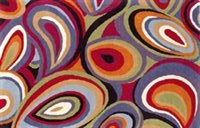So you’ve decided to introduce color, but how do you select shades from the thousands of choices out there? Homeowners say this is their biggest challenge – just too many colors to choose from.
While it’s true there are more color options in paint, stain and fabrics than ever before, that needn’t worry you too much. Some of those shades will not appeal to you. Others won’t really work with your existing furnishings or style of home. So right off the bat, you can eliminate certain ranges of color and start zeroing in on the ones that will suit you best.
Again, any major furnishings or hard fixtures (i.e. flooring, granite, brick or stone) in the space will determine the range of colors that will look good. But among that range, what appeals to you? Or suppose you’re practically starting from scratch, with nothing but a white couch and wood floors. How do you get a direction?
Of course, one reliable method is to study home decorating magazines and even circulars you get in the mail from home furnishing outlets. Look for colors and sets that catch your eye; tear them out and set them aside. Going back, you may start to see a pattern of what appeals to you.
A less obvious -but quite effective- place to get color ideas is the fabric store. Because you can see large segments of color by unrolling a bolt of material, you get a real sense of what it might feel like used on a wall or as a drape. Just walk around and look, without regard to what you might actually buy. Do you find yourself drawn to a particular part of the spectrum, like cool, watery blues and greens, or warm, vivid corals and hot pinks?
Glance in your closet: do you gravitate toward certain shades in clothing? Would these work for a room? Even a favorite piece of jewelry can produce color clues.
Shopping the vignettes in home furnishing stores like IKEA, World Market or Pier One can be especially helpful. Some stores paint sample walls behind the display, allowing you to see both wall and furnishing colors together.
Nature is another source of potential color palettes: look at the colors native to your part of the country, or what’s in your own garden. Selecting colors from natural materials like bark, stone, water or plants will produce a soothing feel. Adding in bright shades from blooming flowers will create a more energetic atmosphere.
Finally, let me share my favorite color secret. If you are buying an area rug, pick the rug FIRST, then base your entire color palette on that. If you like the way the colors look together in the rug, chances are good you’ll like them in the room or rooms being decorated.
 Note this festive rug is from one of my favorite sites, floorsandsurfaces.com, this rug from the Nolita collection offers many color combinations that could be translated into colors for walls, drapes, pillows or art.
Note this festive rug is from one of my favorite sites, floorsandsurfaces.com, this rug from the Nolita collection offers many color combinations that could be translated into colors for walls, drapes, pillows or art.
Paint colors such as these could be carried throughout several adjoining rooms, or you could limit the energy by using Blonde as a neutral between two more brightly-colored rooms.
Yes, you can create a scheme, then find a rug to match. But it is so much faster and easier to do the reverse. Remember that paint can be mixed to any shade in the universe, and even drapes can be custom-made if needed to get a proper match. But your rug color combinations are pre-determined.
Further, if you are working with a designer or color consultant, your choice of rug can give them a good idea of the mood you want to set for the entire room
Painting a home or office in the Dallas area, and need help selecting colors? – Paint Color Help.com, It’s my mission to help you find the perfect colors in less time, reducing frustration and keeping you motivated to finish your project.


